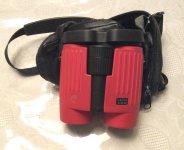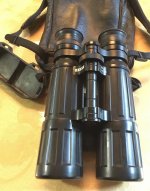I'm sure you all know and have experienced what I’m talking about.
It’s just like with movies or cars. Some of them drove us crazy 20, 30, 40 years ago, we thought they were unsurpassable; it seemed that there was no point beyond, that no matter how hard they tried, no one would ever come up with anything better.
And, oh well, this is until you revisit the movie/car in question to discover with horror that your idol from yesteryear has not aged very well, to put it mildly… Or, on the contrary, you look at a GTO or an F40 and you think that in many cases they can keep up (at least in some areas) with current production. It might be that they were actually ahead of their time or simply put, there’s something about them: ease of use, handling, comfort that simply has not been surpassed, even if the pure performance of the newest and greatest is obviously better.
Why am I writing all this? Well, it is not the first time I feel the same way about some binoculars in particular. I’ve been using a 7x42 Leica BA and I’m frankly quite amazed about the view (yes, it weights more or less like the Titanic and it should come with discount vouchers for a physiotherapist specialised in neck injures). But this 20 year old view leaves you in awe; at least it leaves me in awe: so sweet, sharp and overall pleasant and easy. Something similar can be said about the Zeiss Dialyt 7x42 BGATP 7x42, the 1998 Nikon SE or the 1999 Nikon EII, to name a few very well known examples. On the other hand, devices like the Zeiss Diafun don't seem to have aged well, they're hardly ever used as a reference and they seem almost gone from the classified ads and auction websites.
So, for those of you who have been around for long time… as a special treat for young (at heart) binocular fans who might not have all that expertise: which would you say are the binoculars that have aged really well, and which have aged poorly.
As an example to set the ball rolling: in my humble opinion, the Leica 7x42 BA has a pretty convincing performance (weight aside).
Thank you all for your contributions!
It’s just like with movies or cars. Some of them drove us crazy 20, 30, 40 years ago, we thought they were unsurpassable; it seemed that there was no point beyond, that no matter how hard they tried, no one would ever come up with anything better.
And, oh well, this is until you revisit the movie/car in question to discover with horror that your idol from yesteryear has not aged very well, to put it mildly… Or, on the contrary, you look at a GTO or an F40 and you think that in many cases they can keep up (at least in some areas) with current production. It might be that they were actually ahead of their time or simply put, there’s something about them: ease of use, handling, comfort that simply has not been surpassed, even if the pure performance of the newest and greatest is obviously better.
Why am I writing all this? Well, it is not the first time I feel the same way about some binoculars in particular. I’ve been using a 7x42 Leica BA and I’m frankly quite amazed about the view (yes, it weights more or less like the Titanic and it should come with discount vouchers for a physiotherapist specialised in neck injures). But this 20 year old view leaves you in awe; at least it leaves me in awe: so sweet, sharp and overall pleasant and easy. Something similar can be said about the Zeiss Dialyt 7x42 BGATP 7x42, the 1998 Nikon SE or the 1999 Nikon EII, to name a few very well known examples. On the other hand, devices like the Zeiss Diafun don't seem to have aged well, they're hardly ever used as a reference and they seem almost gone from the classified ads and auction websites.
So, for those of you who have been around for long time… as a special treat for young (at heart) binocular fans who might not have all that expertise: which would you say are the binoculars that have aged really well, and which have aged poorly.
As an example to set the ball rolling: in my humble opinion, the Leica 7x42 BA has a pretty convincing performance (weight aside).
Thank you all for your contributions!
Last edited:






